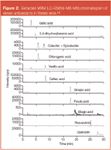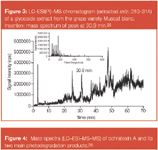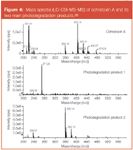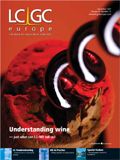In Vino Veritas: LC–MS in Wine Analysis
LCGC Europe
Liquid chromatography–mass spectrometry (LC–MS) is a popular technique for the analysis of wine. This article gives an overview of wine analysis and new insights this technique has revealed regarding the composition of wine, possible health benefits, customer safety and the understanding of winemaking processes.
Mass spectrometry (MS) is almost a hundred years old, but the coupling of MS with liquid chromatography (LC) is still in its youth and began in the mid-seventies. However, the real advances in this hyphenated technique began in the early eighties with the introduction of fast-atom bombardment (FAB) and thermospray ionization (TS), which led to the development of atmospheric-pressure chemical ionization (APCI).
The most famous ionization sources — electrospray ionization (ESI) and matrix-assisted laser desorption ionization (MALDI) — followed five to seven years later. The next fundamental development for the incredible growth of the LC–MS instrumentation was catalysed by the popularization of "lightweight" mass analysers, such as quadrupoles and ion traps, the revival of time-of-flight (TOF) analysers, and the introduction of the new Orbitrap detector (Thermo Fisher Scientific, San Jose, California, USA).
These analysers are now available in a wide variety of combinations that allow users to work with tandem MS in a simple, problem-free manner. LC–MS has entered the field of organic analytics in a big way and changed the perspectives and direction of many research fields, including the composition of food and beverages. This article looks at the analysis of wine and the new insights that LC–MS has revealed regarding its composition, health aspects and winemaking practices (Figure 1).

Figure 1
The Colour of Wine
Even to lay eyes, the different colour nuances of young and aged red wines are clearly visible. It has been known for at least 30 years that this colour change results from the reactions of wine pigments called anthocyanidins with other compounds present in wine.1 There are five anthocyanidins present in grapes as conjugates, mainly glycosides (anthocyanins). Their analysis by LC–MS can be accomplished using APCI, ESI or MALDI ionization, and different tandem MS scanning modes allow their determination in complex mixtures.2 The study of anthocyanic composition can be used to characterize the grape/wine variety and addition of hybrid grape varieties.3 The true value of LC–MS, however, lies in the fact that it allows the identification of pigments formed during wine maturation and resulting from the anthocyanin condensation reactions with pyruvic acid, acetaldehyde,4 tannins,5 furfural derivatives,6 vinylepicatechin,7 to name just a few, and also from anthocyanin polymerization.1,8 ESI, particularly in negative ionization mode, has become indispensable in these studies.5,6,8 The new (non-polymeric) pigments have been named pyranoanthocyanins and are chemically more stable than grape anthocyanins, but their structural diversity is enormous and they continue to form endlessly during wine ageing.1,7,8 To further complicate matters, a recent LC–ESI–MS analysis indicated that anthocyanin oligomers are already present in grape skin extract.9
The colour change of white wines involves a different mechanism: the browning has been shown to be induced by glycoaldehyde, resulting from malolactic fermentation of wine.3

Keynotes:
Keeping the Doctor Away?
A glass of wine a day keeps the doctor away. Or at least that's what we think should be the new maxim for the grown-up population. A vast body of research in polyphenolic compounds, mainly by the aid of LC–MS methods, has resulted in their great popularity as antioxidants and as protective agents for vascular health.10 Wine is also rich in polyphenolics, mainly flavanol monomers, oligomers (procyanidins) and glycosides.1 Several important oligomers with molecular weights (MWs) above 1000 have been identified in grape seed by MALDI-MS,11 but their presence in wine depends greatly on the winemaking practice (e.g., postfermentative maceration).12 Other important phenolic compounds are also flavanonols and phenolic acids, present in significant amounts in grape stems.13 The great structural diversity of polyphenols found in wine makes LC–MS the most suitable method for their identification and quantification.14 Different ionizations are used: FAB, APCI, ESI, MALDI, often in conjunction with tandem MS. Generally, negative ionization (NI) has proven to be more efficient than positive (PI) for these compounds.14 An example of LC–MS–MS multiple-reaction monitoring chromatogram (ESI-NI) of wine phenolics is shown in Figure 2.

Figure 2
The total polyphenol content in wines is usually determined using the Folin-Ciocalteu method, and some studies have shown good correlation between this method, LC–MS–MS analyses and the antioxidant activity determined by ABTS.16
Another group of health-affecting compounds in wine are stilbenoids or phytoalexins, important for their strong antioxidant, antimicrobial and anticancer properties, which are synthesized by plants in defence against pathogens or stress.17 The most important and commonly found is resveratrol with its glycosides, and LC–MS (PI–APCI) seems also to be the most suitable method for its determination.18 Some other physiologically active stilbenes have also been identified in grapes by LC–ESI–MS: δ-viniferin19 and piceatannol,20 previously thought to occur only in non-edible plants.
LC–MS has enabled the fate of polyphenols and stilbenoids in vivo after their ingestion to be followed. Their absorption in the intestines was studied 21 and their metabolites have been identified.22 It has also been shown that polyphenol metabolites cross the blood–brain barrier and can, therefore, also exhibit their protective effects in the brain.23
Aftertaste
The truth is that although wine has actually been confirmed to be healthy, we still drink it because of its pleasant taste and aroma (among other reasons). Wine aroma is detected primarily through the sense of smell: thus the main constituents are volatile compounds, (e.g., monoterpenes and aldehydes, which are more readily analysed by GC–MS than by LC–MS).3 However, the majority of terpenes and some other odorous compounds are present in grapes in the form of precursors: glycosides and other conjugates. They are only partially released during fermentation.
Terpene glycosides remain almost unexplored as LC–MS analytes,24 although they are theoretically amenable to it.8 An example of the PI–ESI–MS spectrum of a compound from grape extract, tentatively identified as a terpene glycoside, is shown in Figure 3. Apart from volatile compounds, the perception of wine in the mouth is important for a harmonic sensation. The taste perception of wine is dominated by phenolic compounds.1 Higher MW tannins interact with salivary proteins and cause astringency, while flavanol monomers cause bitterness.1 Most of these compounds have been determined and characterized by LC–MS.14 Bitterness and astringency have also been ascribed to triterpenes, which are along with some tannins extracted from oakwood used for ageing of some wines. Electrospray in NI mode is an effective type of ionization for these compounds and their determination by LC–MS in beverages.26

Figure 3
Carboxylic acids have an important contribution to the overall wine flavour. Although they can be determined by other means, ion exclusion chromatography (IEC) with APCI–MS is one of the more selective and sensitive methods.27
Recent research in human receptors has led to the discovery of specific triggering "taste molecules". Generally, they are relatively polar and high-MW and are, therefore, excellent candidates for LC–MS determination. One of them, N-lactoyl ethanolamine, has been identified in wine using LC–MS–MS.28
Pig in a Poke
As with anything we eat or drink, special emphasis should be on wine quality and control of potentially harmful substances. The idea of quality encompasses many things: as well as fine flavour and lack of taints a consumer expects wine to be made of a declared grape variety, although sometimes this may not be the case. Identification of grape variety used for the production of a given wine is extremely difficult and relies mainly on aroma compounds determined with GC–MS.25,29 The first glimpse at a possible solution was an LC–ESI–MS characterization of resistant, haze-forming proteins in wine, which turned out to be pathogenesis-related (PR) proteins, persisting throughout the complete wine-making process and seemingly characteristic of the grape variety.8,29 The theory was confirmed also for other grape varieties and using different MS approaches: ESI, nano-ESI, MALDI–TOF.30
Quite another problem is the presence of harmful substances in wine, be it naturally-occurring or introduced by humans. The list of possible culprits is getting longer every year. The permanent candidates are various pesticides used in the grape-growing practice. Most of them are suitable for GC–MS analysis, but there are also some polar compounds which are better determined with LC–MS after an appropriate sample preparation procedure: azole fungicides (ESI, MS–MS),31 dicarboximide fungicides (APCI), phenylurea and carbamate herbicides (PI and NI APCI or ESI).32,33 More unusual is the contamination of wine with "alcohol-based brine" (alcohol or glycol for refrigeration), which can be detected through the additive rhodamine by LC–MS–MS.8
The most problematic of naturally-occurring toxins in wine are those produced by various fungi growing on grapes (mycotoxins). Ochratoxin A is probably the most frequently present, and several LC–MS procedures have been proposed for its monitoring.32,34 Its determination, however, is complicated because ochratoxin slowly degrades under the influence of sunlight into several products, which have been identified by LC–ESI–MS–MS (Figure 4).35 Another, less common mycotoxin alternariol has also been detected in wine using LC–MS–MS with APCI or ESI.36

Figure 4
Biogenic amines, which exhibit several physiological functions and are also mutagenic, can be found in wine and have been analysed by LC–TSP–MS.32
History
It is known from historical records that grapevine has been grown and wine produced in the Mediterranean basin already for some 5000 years, yet we do not know much more than that. A recent application of LC–MS–MS for identification of traces of wine markers in ancient Egyptian vessels revealed that they had been used for storage of red wine. A common wine marker is tartaric acid, while syringic acid is the product derived from malvidin, a red wine pigment.37
Helena Prosen is an associate professor of analytical chemistry at University of Ljubljana, Faculty of Chemistry and Chemical Technology, her research interests include sample preparation, chromatographic and mass spectrometric methods in the field of natural products research, food and environmental analysis.
Matija Strlics is a professor of analytical chemistry at University of Ljubljana, Faculty of Chemistry and Chemical Technology, where his research encompasses new analytical approaches in characterisation and stabilization of organic materials, environmental assessment and food analysis.
Drago Kocsar is a researcher at University of Ljubljana, Faculty of Chemistry and Chemical Technology, his main research interests are polymer analysis and development of LC–MS methods for a broad range of samples: wine analysis, determination of pharmaceuticals in wastewater and others.
Denis Rusjan is an associate professor at University of Ljubljana, Biotechnical Faculty, where he researches new approaches in grapevine-growing and influence of various parameters during wine production on its quality.
References
1. V. Cheynier et al., Am. J. Enol. Vitic., 57(3), 298–305 (2006).
2. Q. Tian et al., J. Chromatogr. A, 1091(1–2), 72–82 (2005).
3. R. Flamini, J. Mass Spectrom., 40(6), 705–713 (2005).
4. A. Heier et al., Am. J. Enol. Vitic., 53(1), 78–86 (2002).
5. S. Remy et al., J. Sci. Food Agric., 80(6), 745–751 (2000).
6. N.-E. Es-Safi, V. Cheynier and M. Moutounet, J. Agric. Food Chem., 50(20), 5586–5595 (2002).
7. E.M. Francia-Aricha et al., J. Agric. Food Chem., 45(6), 2262–2266 (1997).
8. Y. Hayasaka, G.A. Baldock and A.P. Pollnitz, Austr. J. Grape Wine Res., 11(2), 188–204 (2005).
9. S. Vidal et al., J. Agric. Food Chem., 52(23), 7144–7151 (2004).
10. R. Corder et al., Nature, 444(7119), 566 (2006).
11. H.A. Weber et al., J. Agric. Food Chem., 55(1), 148–156 (2007).
12. S. González-Manzano et al., J. Agric. Food Chem., 54(12), 4326–4332 (2006).
13. J.M. Souquet, et al., J. Agric. Food Chem., 48(4), 1076–1080 (2000).
14. E. de Rijke et al., J. Chromatogr. A, 1112(1–2), 31–63 (2006).
15. D. Koscar et al., 12th Intern. Symposium on Sep. Sciences, 27–29 Sept. 2006, Lipica, Slovenia, Book of Abstracts (Ed. M. Strlisc, W. Buchberger), SKD Ljubljana 2006.
16. Á.M. Alonso Borbalán et al., J. Chromatogr. A, 1012(1), 31–38 (2003).
17. P. Jeandet et al., J. Agric. Food Chem., 50(10), 2731–2741 (2002).
18. Y. Wang et al., J. Agric. Food. Chem., 50(3), 431–435 (2002).
19. R. Pezet et al., J. Agric. Food Chem., 51(18), 5488–5492 (2003).
20. L. Bavaresco et al., Vitis, 41(3), 133–136 (2002).
21. A. Maier-Salamon et al., Pharm. Res., 23(9), 2107–2115 (2006).
22. C. Yu et al., Pharm. Res., 19(12), 1907–1914 (2002).
23. M.M. Abd El Mohsen et al., Free Radical Biol. Med., 33(12), 1693–1702 (2002).
24. V.A. Marinos, M.E. Tateo and P.J. Williams, J. Agric. Food Chem., 42,(11), 2486–2492 (1994).
25. H. Prosen et al., Acta Chim. Slov., 54(1), 25–32 (2007).
26. G. Arramon et al., LCGC Asia Pacific, 7(1), 910–918 (2004).
27. M.I.H. Helaleh et al., J. Chromatogr. A, 956(1–2), 201–208 (2002).
28. E. de Rijke et al., Mol. Nutr. Food Res., 50(4–5), 351–355 (2006).
29. Y. Hayasaka et al., J. Agric. Food Chem., 49(4), 1830–1839 (2001).
30. R. Flamini and M. De Rosso, Expert Rev. Proteomics, 3(3), 321–331 (2006).
31. E.R. Trösken, N. Bittner and W. Völkel, J. Chromatogr. A, 1083(1–2) 113–119 (2005).
32. R. Flamini and A. Panighel, Mass Spectrom. Rev., 25(5), 741–774 (2006).
33. T. Goto et al., Anal. Chim. Acta, 531(1), 79–86 (2005).
34. A. Leitner et al., Anal. Chim. Acta, 453(1), 33–41 (2002).
35. I. Kralj Cigic et al., Anal. Lett., 39(7), 1475–1488 (2006).
36. B.P.Y. Lau et al., J. Chromatogr. A, 998(1–2), 119–131 (2003).
37. M.R. Guasch-Jané et al., Anal. Chem., 76(6), 1672–1677 (2004).
Analytical Challenges in Measuring Migration from Food Contact Materials
November 2nd 2015Food contact materials contain low molecular weight additives and processing aids which can migrate into foods leading to trace levels of contamination. Food safety is ensured through regulations, comprising compositional controls and migration limits, which present a significant analytical challenge to the food industry to ensure compliance and demonstrate due diligence. Of the various analytical approaches, LC-MS/MS has proved to be an essential tool in monitoring migration of target compounds into foods, and more sophisticated approaches such as LC-high resolution MS (Orbitrap) are being increasingly used for untargeted analysis to monitor non-intentionally added substances. This podcast will provide an overview to this area, illustrated with various applications showing current approaches being employed.
Advances in Non-Targeted Analysis for PFAS in Environmental Matrices
March 27th 2025David Megson from Manchester Metropolitan University in Manchester, UK, spoke to LCGC International about the latest developments in non-targeted analysis (NTA) of per- and polyfluoroalkyl substances (PFAS) in environmental matrices based on a recent systematic review paper he has collaboratively published (1).
Study Explores Thin-Film Extraction of Biogenic Amines via HPLC-MS/MS
March 27th 2025Scientists from Tabriz University and the University of Tabriz explored cellulose acetate-UiO-66-COOH as an affordable coating sorbent for thin film extraction of biogenic amines from cheese and alcohol-free beverages using HPLC-MS/MS.














